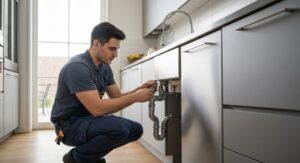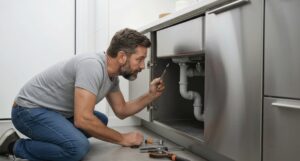Your home’s plumbing system works tirelessly behind the scenes, but it’s often ignored until a disaster strikes. A sudden pipe burst or a backed-up sewer line can cause immense stress and expensive damage. The good news is that most of these emergencies are preventable. By implementing a monthly plumbing maintenance checklist, you can catch small issues before they escalate. This guide provides a straightforward monthly plumbing maintenance checklist to help you protect your home, conserve water, and keep your plumbing system in peak condition.
Why Monthly Plumbing Maintenance Matters
Ignoring your plumbing system can lead to far more than a minor inconvenience. A small, undetected leak behind a wall can silently rot structural wood and trigger hazardous mold growth, creating a serious health risk for your family. Even a single dripping faucet can waste dozens of gallons of water each year, leading to unnecessarily high utility bills.
Furthermore, neglecting regular plumbing maintenance for your drains can cause grease, hair, and other debris to build up. Over time, this accumulation creates stubborn clogs that can result in sewage backing up into your sinks, showers, or tubs. This is not only unsanitary but also requires costly emergency repairs.
Ultimately, putting off plumbing maintenance exposes your home to the risk of catastrophic failure, like a burst pipe that can flood your home in minutes. The cost of repairing water damage, replacing flooring, and dealing with mold remediation far exceeds the small amount of time and effort required for preventative care.
Essential Monthly Plumbing Maintenance Tasks
Now that you understand the importance of upkeep, what actions should you take? An effective plumbing maintenance checklist doesn’t have to be complicated. A few key tasks performed each month can make all the difference in preventing major problems and keeping your system running efficiently.
Checking for Leaks in Pipes, Faucets, and Fixtures
One of the most vital tasks on your plumbing maintenance checklist is a thorough inspection for leaks. Start by looking under all the sinks in your kitchen and bathrooms. Scan the pipes and cabinet floors for any signs of moisture, water stains, mold, or musty smells. Pay close attention to the joints, as these are common failure points.
Next, check your fixtures. Are any of your faucets dripping? Even a slow drip wastes water and can indicate a worn-out washer. To check for a silent toilet leak, a common source of wasted water, use this simple trick:
- Add a few drops of food coloring to your toilet tank.
- Wait for about 30 minutes without flushing.
- If you see any color appear in the toilet bowl, you have a leak, likely from a faulty flapper.
Checking these areas monthly helps you catch problems before they cause significant water damage or spike your utility bill. A quick visual scan is all it takes to protect your plumbing system.
Testing Water Pressure and Flow Rates
Your home’s water pressure plays a huge role in the health of your plumbing system. Pressure that is too high puts excessive strain on your pipes, joints, and appliances, leading to leaks and premature failure. You can easily test it yourself as part of your regular plumbing maintenance routine.
To do this, purchase a simple water pressure gauge from a hardware store. Attach it to an outdoor hose bib or a washing machine faucet and turn the water on fully. The ideal residential water pressure is between 40 and 60 pounds per square inch (PSI).
If your reading is above 80 PSI, you should adjust your home’s pressure regulator, which is typically located near the main water shut-off valve. Consistently monitoring your water pressure with this simple step on your maintenance checklist can prevent a host of expensive problems down the road.
Key Signs of Potential Plumbing Problems
Being observant is your first line of defense in plumbing maintenance. Your eyes and ears can detect subtle clues that something is wrong with your plumbing system. When performing your monthly inspection, look and listen for any of the following red flags.
These warning signs are your plumbing system’s way of asking for help. Did you notice a sudden drop in water pressure? Are your drains taking longer than usual to clear? These are clear indicators of a potential blockage or leak.
Here are some of the most common signals to add to your maintenance checklist:
- Gurgling sounds coming from your drains
- The sound of running water when all fixtures are off
- Water stains appearing on ceilings or walls
- Slow-draining sinks, tubs, or showers
- Musty or foul odors near drains or in basements
- A sudden, unexplained increase in your water bill
Common Causes of Hidden Leaks or Blockages
Understanding what causes leaks and blockages can help you prevent them. Many hidden issues stem from everyday habits or the natural aging of your plumbing system. For instance, high water pressure continuously strains pipe joints, eventually causing them to fail. Similarly, older pipes can corrode from the inside out, leading to pinhole leaks.
Blockages are most often caused by introducing improper materials into your drains. In the kitchen, pouring grease, fats, or coffee grounds down the sink is a primary cause of stubborn clogs. In the bathroom, flushing anything other than toilet paper and human waste can easily lead to a backup.
Your regular plumbing maintenance should include being mindful of these causes. Following a simple maintenance checklist of dos and don’ts can prevent the majority of clogs and leaks.
| Issue Location | Common Cause |
|---|---|
| Kitchen Sink | Solidified grease, oil, fibrous food waste (e.g., celery, potato peels) |
| Bathroom Sink/Shower | Hair, soap scum, and other non-dissolving debris |
| Toilet | Flushing “flushable” wipes, paper towels, feminine hygiene products |
| Hidden Pipe Leak | Pipe corrosion due to age, excessive water pressure stressing joints |
Residential vs. Commercial Plumbing Maintenance
The primary difference between residential and commercial plumbing maintenance checklists lies in intensity and scope. A residential plumbing system serves a single family, while a commercial system in an office, restaurant, or apartment building endures constant, heavy use from the public and employees.
This high usage means commercial fixtures and pipes are subjected to far more wear and tear. A business’s maintenance checklist must also account for specialized equipment not found in most homes, such as industrial-grade water heaters, grease traps, and backflow preventers, which often have specific maintenance requirements mandated by health and safety codes.
Ultimately, while a homeowner’s checklist focuses on preventing inconvenience, a commercial maintenance checklist is about preventing operational downtime, ensuring public safety, and maintaining compliance with regulations.
| Feature | Residential Checklist | Commercial Checklist |
|---|---|---|
| Usage Scale | Low-volume, single-family use | High-volume, constant public or employee use |
| Fixtures | Standard sinks, toilets, showers | Multiple public restrooms, floor drains, industrial kitchen sinks |
| Specialized Equipment | Garbage disposal, standard water heater | Grease traps, commercial water heaters, sump pumps, backflow preventers |
| Regulatory Focus | General home safety | Strict adherence to health codes, building codes, and ADA compliance |
Keep Your Home Flowing Smoothly with Target Plumbers That You Can Trust
Following a monthly plumbing maintenance checklist is an excellent way to handle the basics of preventative care yourself. However, some tasks require the tools and expertise of a licensed professional. For comprehensive inspections, complex repairs, or any plumbing issue that feels beyond your comfort level, it’s always best to call for expert help. A professional can assess your entire plumbing system, from the water heater to the sewer line, and identify issues you might miss.
At Target Plumbers, we are dedicated to keeping your home’s plumbing system in top condition. Whether you need help with your regular plumbing maintenance, are facing an unexpected leak, or want to schedule an annual professional inspection for total peace of mind, our team is here for you. Trust us to provide reliable, expert service to keep your water flowing smoothly and protect your home from plumbing disasters.
Conclusion
In conclusion, maintaining your plumbing system through our monthly plumbing maintenance checklist outlined above is essential for preventing emergencies and ensuring a smoothly functioning home. By routinely checking for leaks, inspecting major components, and understanding the signs of potential issues, you can save yourself from costly repairs down the line. Remember, proactive maintenance not only keeps your plumbing in good condition but also enhances the longevity of your fixtures and appliances.
This monthly checklist complements the essential tips we shared in Plumbing Maintenance Tips for Homeowners—a must-read for every homeowner who wants to avoid costly plumbing disasters. Keep your home flowing smoothly and avoid disasters by staying informed!
Frequently Asked Questions
How do I create an effective monthly plumbing maintenance routine?
To create an effective routine, list all your plumbing fixtures and appliances. Organize tasks from your plumbing maintenance checklist by frequency (monthly, quarterly, annually) and set calendar reminders. This ensures your entire plumbing system gets the regular plumbing maintenance it needs without being overwhelming.
What should I do if I find a leak during my monthly inspection?
If you find a leak, the first step is to shut off the water supply to that fixture using its local shut-off valve. If you can’t find it or the leak is large, turn off your home’s main water valve and call a professional plumber immediately.
How often does my water heater need to be checked as part of monthly maintenance?
Your water heater should have a visual inspection every month as part of your plumbing maintenance. Check for any leaks, rust, or unusual noises. A more thorough flush to remove sediment should typically be performed by a professional once a year.






